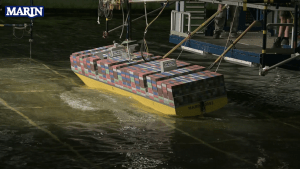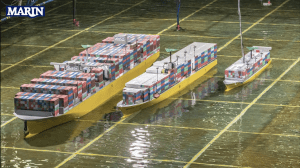After its investigations for the Dutch Safety Board related to the loss of 342 containers north of the Wadden Islands by the MSC ZOE, MARIN performed a further investigation for the Ministry of Infrastructure and Water Management. Beside an Ultra Large Container Ship as the MSC ZOE, a shorter and narrower PANAMAX and a smaller container Feeder were tested. The importance of testing smaller ships was underscored when the feeder ‘Rauma’ lost 7 containers on February 11th 2020. The new MARIN investigations confirm that also smaller containerships can lose containers above the Wadden Islands, in particular due to ‘green water’. Green water is solid seawater that can hit the containers from the side in high waves.
a PANAMAX and Feeder were tested in MARIN test facilities. Both the shallow southern route (21,3m) as well as the deeper northern route (37,5m) were investigated.
Based on the results of the present investigations MARIN derived preliminary limiting wave heightsfor these ship types and routes. With wave heights above these preliminary limiting wave heights, the loading on the ships and their cargoes can exceed their capacity (safe values). They are summarized in the table below, with the limiting mechanism between brackets. The limiting mechanism is different per ship type and route.
These preliminary limiting wave heights for these three containership types are important to reduce the risk of container loss significantly. We recommend to use these wave heights in the advice of the Coast Guard to ships sailing in the area and further decision making.
To come to the final limiting wave heights, it is needed to investigate the problem of water loading on smaller ships such as Feeders with their low freeboard. It is further important to use these results for three (average) containerships in a risk analysis that includes all ships and conditions that sail in this area. Based on this it can be determined how the risk of containers in this Particularly Sensitive Sea Area (PSSA) can be minimized.
This also requires more transparent and consistent rules and regulations of international organizations such as IMO and the class societies. MARIN has observed that it is not transparent what the design limits are for the ship, cargo and cargo securing equipment and how they are determined. MARIN wants to support the governments (coastal and flag states) and companies involved by starting the international ‘Top Tier’ Joint Industry Project (JIP), as follow up of the
‘Lashing @ Sea’ JIP that was performed successfully in the past. For more information on the ‘Top Tier’ JIP, please contact Jos Koning: j.koning@marin.nl.
The summary of the MARIN report and the complete report can be downloaded below.




